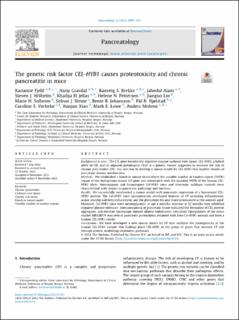| dc.contributor.author | Fjeld, Karianne | |
| dc.contributor.author | Svanbring, Anny Gravdal | |
| dc.contributor.author | Brekke, Ranveig Seim | |
| dc.contributor.author | Alam, Jahedul | |
| dc.contributor.author | Wilhelm, Steven J. | |
| dc.contributor.author | el Jellas, Khadija | |
| dc.contributor.author | Pettersen, Helene Nazmiye | |
| dc.contributor.author | Lin, Jianguo | |
| dc.contributor.author | Solheim, Marie Holm | |
| dc.contributor.author | Steine, Solrun | |
| dc.contributor.author | Johansson, Bente Berg | |
| dc.contributor.author | Njølstad, Pål Rasmus | |
| dc.contributor.author | Verbeke, Caroline Sophie | |
| dc.contributor.author | Xiao, Xunjun | |
| dc.contributor.author | Lowe, Mark E. | |
| dc.contributor.author | Molven, Anders | |
| dc.date.accessioned | 2022-12-19T14:59:19Z | |
| dc.date.available | 2022-12-19T14:59:19Z | |
| dc.date.created | 2022-11-24T20:51:57Z | |
| dc.date.issued | 2022 | |
| dc.identifier.issn | 1424-3903 | |
| dc.identifier.uri | https://hdl.handle.net/11250/3038662 | |
| dc.description.abstract | Background & aims: The CEL gene encodes the digestive enzyme carboxyl ester lipase. CEL-HYB1, a hybrid allele of CEL and its adjacent pseudogene CELP, is a genetic variant suggested to increase the risk of chronic pancreatitis (CP). Our aim was to develop a mouse model for CEL-HYB1 that enables studies of pancreatic disease mechanisms.
Methods: We established a knock-in mouse strain where the variable number of tandem repeat (VNTR) region of the endogenous mouse Cel gene was substituted with the mutated VNTR of the human CEL-HYB1 allele. Heterozygous and homozygous Cel-HYB1 mice and littermate wildtype controls were characterized with respect to pancreatic pathology and function.
Results: We successfully constructed a mouse model with pancreatic expression of a humanized CEL-HYB1 protein. The Cel-HYB1 mice spontaneously developed features of CP including inflammation, acinar atrophy and fatty replacement, and the phenotype became more pronounced as the animals aged. Moreover, Cel-HYB1 mice were normoglycemic at age 6 months, whereas at 12 months they exhibited impaired glucose tolerance. Immunostaining of pancreatic tissue indicated the formation of CEL protein aggregates, and electron microscopy showed dilated endoplasmic reticulum. Upregulation of the stress marker BiP/GRP78 was seen in pancreatic parenchyma obtained both from Cel-HYB1 animals and from a human CEL-HYB1 carrier.
Conclusions: We have developed a new mouse model for CP that confirms the pathogenicity of the human CEL-HYB1 variant. Our findings place CEL-HYB1 in the group of genes that increase CP risk through protein misfolding-dependent pathways. | en_US |
| dc.language.iso | eng | en_US |
| dc.publisher | Elsevier | en_US |
| dc.rights | Navngivelse 4.0 Internasjonal | * |
| dc.rights.uri | http://creativecommons.org/licenses/by/4.0/deed.no | * |
| dc.title | The genetic risk factor CEL-HYB1 causes proteotoxicity and chronic pancreatitis in mice | en_US |
| dc.type | Journal article | en_US |
| dc.type | Peer reviewed | en_US |
| dc.description.version | publishedVersion | en_US |
| dc.rights.holder | Copyright 2022 the authors | en_US |
| dc.source.articlenumber | 1099-1111 | en_US |
| cristin.ispublished | true | |
| cristin.fulltext | original | |
| cristin.qualitycode | 1 | |
| dc.identifier.doi | 10.1016/j.pan.2022.11.003 | |
| dc.identifier.cristin | 2080521 | |
| dc.source.journal | Pancreatology | en_US |
| dc.identifier.citation | Pancreatology. 2022, 22 (8), 1099-1111. | en_US |
| dc.source.volume | 22 | en_US |
| dc.source.issue | 8 | en_US |

